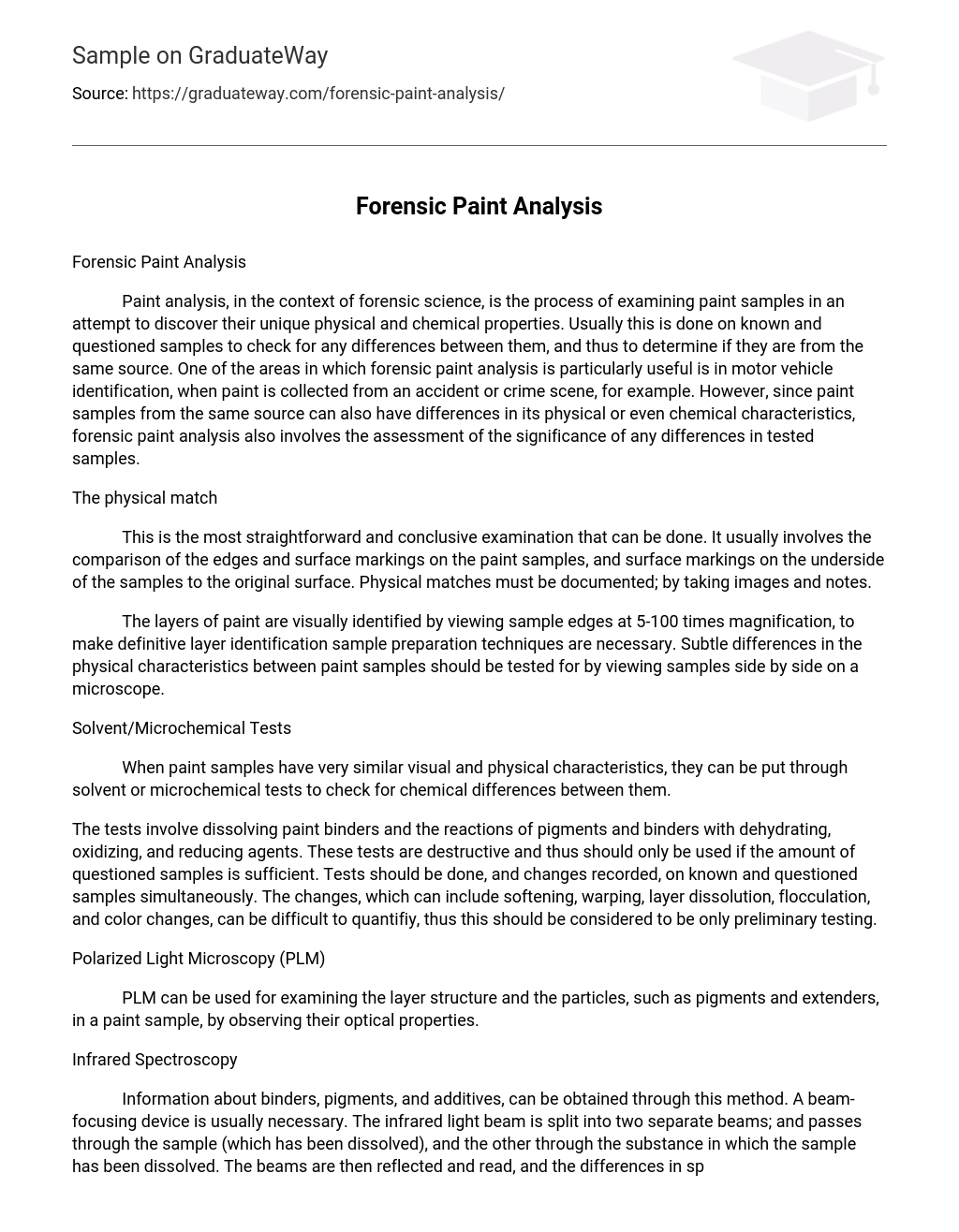Paint analysis, in the context of forensic science, is the process of examining paint samples in an attempt to discover their unique physical and chemical properties. Usually this is done on known and questioned samples to check for any differences between them, and thus to determine if they are from the same source. One of the areas in which forensic paint analysis is particularly useful is in motor vehicle identification, when paint is collected from an accident or crime scene, for example. However, since paint samples from the same source can also have differences in its physical or even chemical characteristics, forensic paint analysis also involves the assessment of the significance of any differences in tested samples.
The physical match
This is the most straightforward and conclusive examination that can be done. It usually involves the comparison of the edges and surface markings on the paint samples, and surface markings on the underside of the samples to the original surface. Physical matches must be documented; by taking images and notes.
The layers of paint are visually identified by viewing sample edges at 5-100 times magnification, to make definitive layer identification sample preparation techniques are necessary. Subtle differences in the physical characteristics between paint samples should be tested for by viewing samples side by side on a microscope.
Solvent/Microchemical Tests
When paint samples have very similar visual and physical characteristics, they can be put through solvent or microchemical tests to check for chemical differences between them.
The tests involve dissolving paint binders and the reactions of pigments and binders with dehydrating, oxidizing, and reducing agents. These tests are destructive and thus should only be used if the amount of questioned samples is sufficient. Tests should be done, and changes recorded, on known and questioned samples simultaneously. The changes, which can include softening, warping, layer dissolution, flocculation, and color changes, can be difficult to quantifiy, thus this should be considered to be only preliminary testing.
Polarized Light Microscopy (PLM)
PLM can be used for examining the layer structure and the particles, such as pigments and extenders, in a paint sample, by observing their optical properties.
Infrared Spectroscopy
Information about binders, pigments, and additives, can be obtained through this method. A beam-focusing device is usually necessary. The infrared light beam is split into two separate beams; and passes through the sample (which has been dissolved), and the other through the substance in which the sample has been dissolved. The beams are then reflected and read, and the differences in spectral absorption patterns are obtained.
Pyrolysis Gas Chromatography (PGC)
Chromatography is a family of analytical chemistry techniques for the separation of mixtures. In gas chromatography a substance is processed in a chromatograph, which separates the chemicals into its component parts because of the different migration rates of the components of the substance through the chromatographic medium because of different affinity values.
Pyrolysis gas chromatography involves heating samples for several seconds at very high temperatures (such as 600 degrees Celsius) inside a pyrolysis unit, which provides an oxygen-free environment.
Microspectrophotometry
In this method light absorption spectrum of a sample is determined, by which its chemical composition can be analyzed. A microscopic thin beam of light is shone through a sample, and light that is not absorbed in captured the a detector.
Scanning Electron Microscopy
This method involves visual examination of the sample using a scanning electron microscope, which can produce very high-resolution images of a surface. It is particularly useful for determining the surface structure, and also for elemental composition, of paint samples.
X-Ray Fluorescence Spectrometry (XRF)
XRF is a non-destructive method of identifying elements and determining their concentrations in the sample. Using the XRF spectrometer, the individual component wavelengths of the fluorescent emission of the sample when subjected to X-rays can be measured.
Some other techniques, not as commonly used, are fluorescence microscopy, low-temperature ashing, solvent extraction, analytical electron microscopy, and cathodoluminescence.
There are many different techniques in accomplishing the goals of forensic analysis; appropriate forensic paint sample analysis and comparison techniques should typically be decided upon based on the goals of a forensic investigation, sample size, and environmental effects that samples have been subjected to. The wide applicability of forensic paint analysis techniques comes from the fact that paint surfaces are virtually ubiquitous, thus paint analysis is an important part of trace evidence evaluation.
References
Reusch, W. 2004, ‘Infrared Spectroscopy’, Michigan State University,viewed 10 May 2006, <http://www.cem.msu.edu/~reusch/VirtualText/Spectrpy/InfraRed/infrared.htm>.
‘Gas Chromatrography’, 2006, Wikipedia, Wikimedia Foundation, viewed 10 May 2006, <http://en.wikipedia.org/wiki/Gas_chromatography>.
‘Scanning Electron Microscope’, 2006, Wikipedia, Wikimedia Foundation, view 10 May 2006, <http://en.wikipedia.org/wiki/Scanning_electron_microscopy>.
‘Pyrolysis Gas Chromatography Mass Spectrometry (Py/GC/MS)’, 2006, University of Bristol, viewed 10 May 2006, <http://www.bris.ac.uk/nerclsmsf/techniques/pyro.html>.
‘Forensic Paint Analysis and Comparison Guidelines’, 2000, Forensic Science Communications Volume 1 Number 2, Federal Bureau of Investigation, U.S. Department of justice, viewed 10 May 2006, <http://www.fbi.gov/hq/lab/fsc/backissu/july1999/paintb.htm>.





